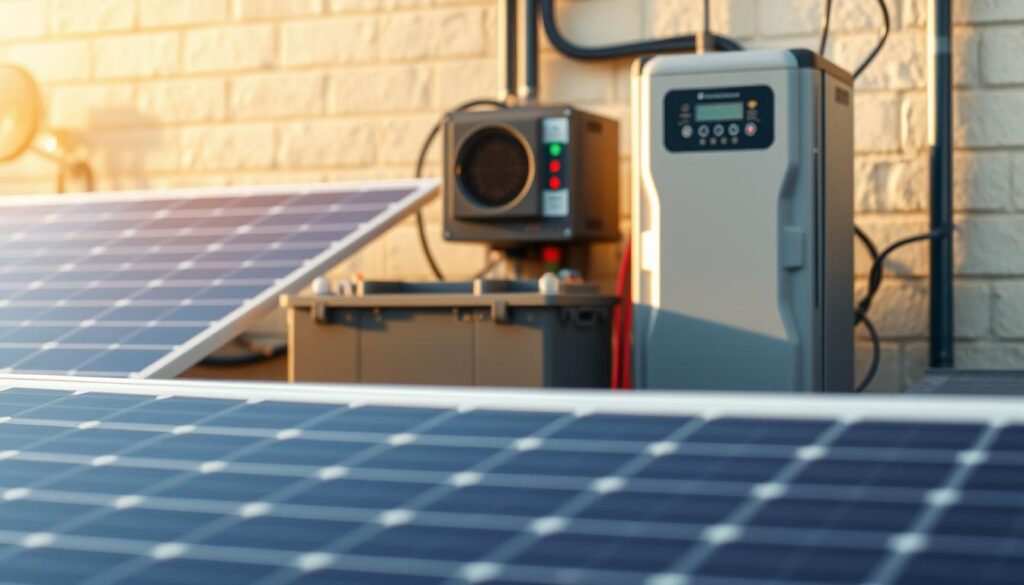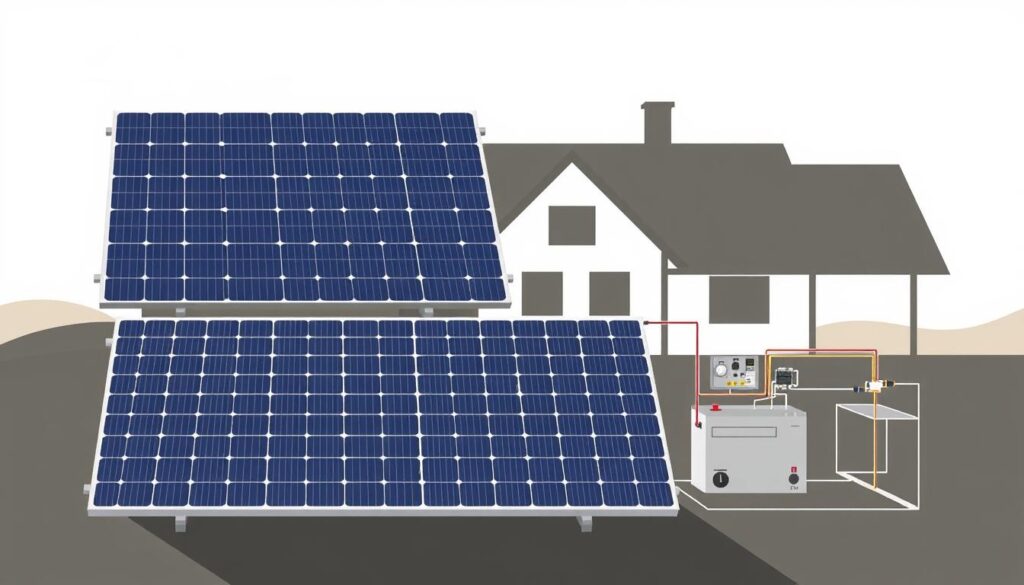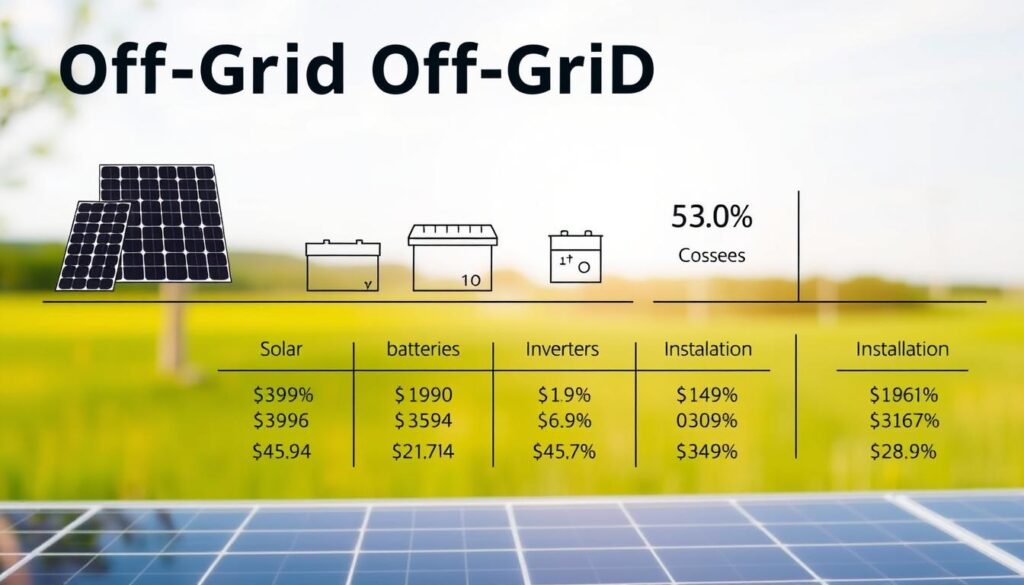A home solar off grid system uses sunlight to power homes without relying on the utility grid. Systems like Goal Zero’s Yeti Power Station combine solar panels and batteries, providing energy for remote cabins, RVs, or home backup. These setups are built to withstand storms and extreme conditions, tested in locations like Everest and Congo villages.
Upgrading to an off-grid system can cut energy costs by up to 50%, and current Spring Sales offer 20% discounts plus free shipping over $500. Solar panels and inverters convert sunlight into usable power, while batteries store energy for use anytime. This setup reduces fossil fuel use and offers long-term savings.
Key Takeaways
- Home solar off grid systems operate independently of the utility grid.
- Save 20% on Spring Sale purchases with free shipping over $500.
- Reduce energy bills by half and lower environmental impact.
- Components like Yeti Power Stations endure extreme weather and outages.
- Batteries and solar panels work together to provide years of reliable power.
Understanding Home Solar Off-Grid Systems
An off grid solar system is a self-sustaining energy solution that powers homes without relying on traditional utility grids. These systems generate, store, and manage electricity entirely on-site, offering complete energy autonomy.
What Defines an Off-Grid Solar System?
At its core, an off grid solar system requires four key components:
- Solar panels to convert sunlight into electricity
- Batteries (like AGM or lithium) to store power
- Charge controllers to regulate battery charging
- Inverters to convert stored DC energy into usable AC power
How Off-Grid Differs from Grid-Tied Systems
Unlike grid-tied setups, off-grid systems cannot draw from utility lines during shortages. They must store all energy via batteries, requiring careful sizing. Grid-tied systems often use net metering to offset costs, while off-grid systems eliminate utility bills entirely. For example, solar panels in off-grid setups account for 100% of energy needs, unlike grid-tied arrays that supplement utility power.
The Evolution of Residential Off-Grid Solar Technology
Early off-grid systems struggled with inefficiency, using bulky lead-acid batteries and low-output panels. Modern advancements now include:
- Monocrystalline panels (25+ year lifespan) with 20%+ efficiency
- Lithium Iron Phosphate (LiFePO4) batteries lasting 10-12 years
- Smart inverters like the Magnum MS4024PAE for 4000W output
“Off-grid systems are like a personal power plant, engineered to match your home’s energy fingerprint.”
Today’s systems even integrate hybrid solutions with backup generators, balancing sustainability with reliability. As technology improves, these setups empower homeowners to reduce grid dependence while managing energy use effectively.
Key Benefits of Going Off the Grid with Solar Power
Off grid solar power transforms homes into self-sustaining energy hubs, offering tangible advantages beyond environmental benefits. These systems empower households to take control of their energy future while shielding budgets from market volatility.
Energy Independence and Self-Sufficiency
By installing off grid solar power, homeowners produce 100% of their electricity needs. Systems like the Tesla Powerwall 3 store daytime energy in batteries, ensuring round-the-clock power. This autonomy is ideal for rural areas where grid connections cost thousands, making solar a smarter long-term investment.
Protection from Rising Utility Costs
With fossil fuel prices soaring, off grid solar power locks in energy costs. Homeowners save 50–90% on bills, and the federal Investment Tax Credit cuts upfront costs by 30%. In Arizona, systems start at $85k, while Massachusetts setups may reach $150k, but long-term savings outweigh initial expenses.
Environmental Impact and Carbon Footprint Reduction
Average households cut 4 tons of CO2 yearly by switching to solar. Systems like the Renogy 800W kit reduce reliance on coal plants, aligning with goals of the MNRE’s solar mission. High-efficiency panels and lithium batteries minimize waste, creating a cleaner energy cycle.
Resilience During Power Outages
When storms hit, grid-tied systems fail—but off-grid setups keep running. Batteries banks store enough energy to power essentials for days, critical in regions like Portugal’s Algarve, where sunny climates maximize solar generation. Durable inverters ensure consistent power, even during extended outages.
Essential Components of a Home Solar Off-Grid System
Residential off grid solar systems rely on four key parts to function: solar panels, charge controllers, inverters, and battery storage. Each plays a role in capturing, storing, and converting sunlight into usable power for homes.

- Solar Panels: Choose from monocrystalline, polycrystalline, or thin-film options. A 60-cell monocrystalline panel produces 300–375 watts, while 72-cell models exceed 375W.
- Charge Controllers: MPPT types boost energy capture by up to 30% more than PWM models, protecting batteries from overcharge damage.
- Inverters: Convert DC battery power to AC for home appliances. High-quality inverters reach 98% efficiency and must match battery voltage (e.g., 12V inverter for a 12V battery bank).
- Batteries: Deep-cycle options like lithium or lead-acid store energy. Lithium batteries last 10+ years and require no maintenance, while lead-acid needs regular checks but costs less upfront.
A well-designed system balances these parts. For example, MPPT controllers paired with lithium batteries maximize energy use. Solar panels must align with a home’s energy needs—typically 1–2 kW per 1,000 sq ft.
| Type | Lifespan | Maintenance | Cost |
|---|---|---|---|
| Lithium | 10+ years | None | High |
| Lead-Acid | 5–10 years | Regular checks | Low |
| AGM | 8–12 years | Minimal | Medium |
Properly matched components ensure reliable power. Solar panels capture sunlight, charge controllers regulate flow, inverters convert energy, and batteries store it. This synergy powers homes without grid reliance.
Sizing Your Off-Grid Solar Energy System Correctly
Designing the right off grid solar energy system starts with knowing how much power your home uses. Start by tracking every device—from lights to refrigerators—and multiply each appliance’s wattage by daily usage hours. A small cabin example shows total daily use at 900 watt-hours, with an inverter adding 160Wh for 24 hours. This baseline ensures your system matches your lifestyle.
Calculating Your Home’s Energy Requirements
- List all devices and their wattage ratings (e.g., TV=100W, fridge=150W).
- Multiply each device’s wattage by daily runtime (e.g., TV 5 hours = 500Wh).
- Add all figures to get total daily watt-hours. Aim for 25% extra to cover inefficiencies.
Determining Solar Panel Capacity
Choose your system voltage based on power needs: 12V for under 1,000W, 24V for 1,000–3,000W, or 48V for over 3,000W. For example, a 900Wh daily load in Seattle would need a 112.94W panel array to handle winter’s 2.5 peak sun hours. Always round up to account for cloud cover and system losses.
Battery Bank Sizing for Energy Storage Needs
Batteries must store enough energy for days without sun. A 2-day autonomy requires doubling daily usage. For a 900Wh system, 1,800Wh of battery capacity is needed. Lead-acid batteries lose 50% of stored energy due to depth of discharge limits, while lithium retains 80% usable capacity. Use this formula: daily use × days of autonomy ÷ battery type efficiency = required battery capacity.
Off-Grid Solar Battery Storage Options
Choosing the right home solar battery backup is critical for uninterrupted power. Two primary battery types dominate: lead-acid and lithium-ion. Their differences in cost, durability, and maintenance shape system reliability.
Lead-Acid vs. Lithium-Ion Batteries
Lithium-ion batteries outlast lead-acid models by years. A lithium battery can handle 3,000–5,000 charge cycles—lasting 10–15 years—while lead-acid only lasts 3–7 years. Lithium’s 95% energy efficiency outperforms lead-acid’s 70% efficacy. Pricing gaps remain: lead-acid costs less upfront but requires frequent replacements.
- Lithium-ion: 10–15-year lifespan, 95% efficiency, low maintenance
- Lithium-ion: 3,000–5,000 recharge cycles
- Lead-acid: 3–7 years, 70% efficiency, needs regular fluid checks
Battery Management Systems (BMS)
BMS technology protects batteries by preventing overcharging or over-discharging. These systems balance voltage across cells, extending battery life. For example, a lithium battery with a BMS can retain 80% capacity after 2,000 cycles, ensuring long-term reliability. Modern BMS also alert users to performance issues via smartphone apps.
Expanding Your Home Solar Battery Backup
Modular systems simplify upgrades. Start with a 10kWh lithium battery and add 2–3kWh increments as needed. This scalability avoids overbuying initially. Combining new and older batteries requires careful pairing to maintain efficiency. Many brands like Tesla Powerwall and Sonnen offer expandable setups.
Planning Your Off-Grid Solar Panel Installation
Planning your off grid solar panel installation ensures your system operates efficiently for years. Start by evaluating your property to find the best location. Look for unshaded areas with clear southern exposure if you’re in the Northern Hemisphere. Tilt angles should match your latitude for maximum sunlight capture.
Consider these key steps:
- Conduct a shading analysis to avoid tree or structure blockage
- Check roof stability if mounting panels on a roof
- Measure available space for ground or pole-mounted systems

Choose between roof mounts for space-constrained properties, ground mounts for larger arrays, or pole mounts for flexible positioning. Always verify local building codes and obtain necessary permits before starting. Safety first: disconnect power sources and use insulated tools during wiring.
Installation steps typically follow this order:
- Secure mounting hardware to your chosen location
- Wire panels to charge controllers and inverters
- Install batteries in a ventilated, secure location
- Complete electrical connections and test the system
DIY installation saves costs but requires electrical knowledge. Partner with certified installers if unsure about wiring or grid disconnection steps. Proper planning turns off grid solar panel installation into a smooth process, ensuring your system meets energy needs safely and efficiently.
Cost Considerations for Residential Off-Grid Solar
Investing in a home solar off grid system requires careful analysis of upfront and ongoing expenses. While costs vary widely, understanding each component helps plan finances wisely.

Initial Investment Breakdown
Most systems start around $40,000 for a 5kW setup, rising to $150,000+ for larger homes. Key costs include:
- Solar panels: $10,000–$18,000 (depending on wattage)
- Batteries: $17,500–$40,000 (lithium-ion lasts longer than lead-acid)
- Inverters: $1,500–$8,000
- Installation labor: 10% of total cost (e.g., $5,000 for a $50,000 system)
Federal and State Incentives
“The federal Investment Tax Credit (ITC) offers 30% off system costs.” – IRS guidelines
States like California and Arizona offer additional rebates. Check the Database of State Incentives for Renewables & Efficiency (DSIRE) for local programs.
Long-Term Savings and Return on Investment
| System Size (kW) | Typical Cost Range |
|---|---|
| 5kW | $40,000–$45,000 |
| 10kW | $70,000–$80,000 |
| 20kW | $100,000–$120,000 |
A 10kW system saves $1,200/year in energy bills. Over 25 years, savings often outweigh costs. Plus, homes with home solar off grid systems gain 1-5% in resale value.
While upfront costs are high, federal incentives and long-term energy independence make this investment viable for many homeowners.
Maintaining Your Home Solar Off-Grid System
Maintaining your off grid solar system ensures it runs efficiently year-round. Regular upkeep prevents costly repairs and extends component lifespans. Follow these steps to keep your system performing at peak capacity:
Seasonal Care for Optimal Function
- Clean panels 1-2 times yearly—more in dusty areas—to remove debris blocking sunlight.
- Clear snow from panels after winter storms to avoid weight stress and shading.
- Trim nearby vegetation to prevent shadows on panels during summer months.
- Check battery terminals quarterly for corrosion and clean with a baking soda solution.
Battery Health Checks
Use a hydrometer (±0.005 accuracy) to measure specific gravity (SG) of flooded lead-acid batteries. Compare readings to manufacturer specs like Rolls battery guidelines. Adjust SG for temperature using the formula: (0.595 × Cell Temp – 12.5)/1000. Top up electrolyte levels with only distilled water when low. Equalize batteries every 6 months to eliminate sulfation buildup.
System Monitoring Tips
Track energy output via digital monitors or manual logs. Look for drops in battery state-of-charge or panel production. Address issues like:
- Low output: Check for loose connections or shading.
- Battery drain: Ensure inverters are turned off during extended absences.
- Uneven cells: Equalize batteries if SG varies more than 0.05 between cells.
Regular maintenance adds years to your system’s lifespan. Follow these steps to keep your off grid solar system running smoothly through all seasons.
Real-World Examples: Successful Off-Grid Solar Homes
Residential off grid solar systems work in real life. Here’s how three U.S. homeowners made it happen:
- Pacific Northwest Cabin: A 400-square-foot cabin in Oregon uses a 6-kW solar array paired with a 390 A/h Discover AES Battery. This setup powers lighting, a fridge, and a wood stove. The owner cut energy use to 6-10 kWh/day by switching to LED bulbs and a propane stove.
- Southwest Desert Home: Near Tucson, Arizona, a family uses 12 solar panels (3.6 kW) and a 12 kWh lithium battery. They run AC, a well pump, and smart home devices. Their system produced 98% of needed energy in 2023, per their inverter logs.
- NE Retrofitted Farmhouse: Vermont’s 180-year-old farmhouse added solar panels, a 10kWh Tesla Powerwall, and a wind turbine. This hybrid system handled winter snow loads and 2023 ice storms, avoiding blackouts that hit the grid.
Each home faced unique hurdles. The cabin owner replaced old lead-acid batteries with lithium to extend lifespan. The desert household optimized shading angles for summer sun. Vermont’s setup used roof-mounted panels plus pole-top wind turbines for year-round generation. “We adjusted routines to match sun cycles,” shared the farmhouse owner. “But the freedom from power bills is worth it.”
Key takeaways: Prioritize energy-efficient appliances, size systems for 7-10 day cloudy weather, and plan for seasonal changes. These real homes prove residential off grid solar isn’t just a dream—it’s a practical choice for those ready to rethink energy use.
Challenges and Considerations Before Going Off-Grid
Transitioning to off grid solar power requires careful planning to address environmental and logistical challenges. Climate and location shape system performance. For instance, snowy regions like Colorado need angled panels to shed snow, while Arizona’s heat demands battery enclosures with cooling vents.
- Mount panels facing south in the US for maximum sun exposure
- Use lithium iron phosphate (LiFePO4) batteries for colder climates
- Install snow guards on racking systems in high-altitude areas
Lifestyle adjustments ensure sustainable energy use. Utah residents in arid zones must monitor water usage closely. Adopting energy-efficient appliances like LED lighting and induction cooktops reduces demand. Scheduling heavy usage during peak sunlight hours maximizes efficiency—think washing laundry at noon instead of midnight.
Backup plans are critical during prolonged cloudy weather. Hybrid systems pairing solar with small wind turbines work well in states like Wyoming. Propane generators provide emergency power during 7+ day overcast periods. The Amish communities in Lancaster County use manual tools alongside solar to balance energy needs.
Key considerations:
– Inspect panels quarterly for debris and corrosion
– Use MPPT charge controllers for 30% better energy capture
– Budget $12,000–$50,000 for starter systems excluding installation costs
Off grid solar power offers freedom but demands proactive management. Research local solar irradiance maps via NREL’s online tools. Consult certified installers like SunPower or Tesla Energy for site assessments. A well-designed system balances upfront costs with decades of clean energy independence.
Conclusion: Is a Home Solar Off-Grid System Right for You?
Deciding on an off grid solar energy system depends on your priorities and circumstances. Ask yourself: Is your location sunny enough for consistent solar production? Can you afford the upfront costs, including battery banks and equipment? Are you ready to monitor energy use closely and handle maintenance? These questions guide whether off-grid living aligns with your lifestyle.
Off-grid systems shine in remote areas without grid access, offering 100% independence. But they demand careful planning. If frequent power outages are a concern, a hybrid grid-tied system with battery backup might balance independence and affordability. Meanwhile, those in urban areas with unstable net metering policies may prefer off-grid to avoid policy changes affecting savings.
Advances in technology are making these systems more accessible. Cheaper panels and longer-lasting lithium batteries reduce long-term costs. Plus, federal tax credits and state incentives lower initial expenses. Even so, upfront investment remains higher than grid-tied setups, requiring a commitment to long-term savings and sustainability.
Choosing an off grid solar energy system means embracing responsibility for your energy use. It’s a path for those willing to adapt habits and embrace renewable tech. If independence and environmental impact matter most, the effort can lead to lasting rewards. Research local incentives, consult installers, and evaluate your needs. The future of clean energy is bright—and it starts with informed decisions today.
